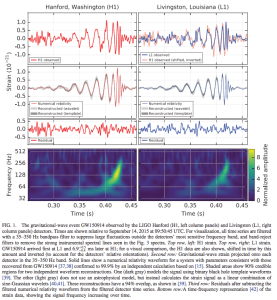Gravitational Waves Discovered in Historic Breakthrough
In a discovery that has been hailed as the breakthrough of the century, scientists have detected clear gravitational wave signals for the first time in history.
The gravitational waves – ripples in spacetime that were anticipated by Albert Einstein – were generated by the collision of two black holes over a billion light-years from Earth. This historic discovery follows decades of speculation, searching and perfecting the sensitive instruments used to identify a distortion in spacetime. Some have claimed it will usher in a new era of astronomy, whilst Stephen Hawking said the discovery was “the real deal, one of those breakthrough moments in science”.
Through decades of research and trial and error, we have managed to detect distortions in spacetime-an endeavour that even Einstein thought would be impossible.
So what are gravitational waves exactly? They are the ripples in the fabric of space-time that are caused by dense, moving objects (such as neutron stars or merging black holes) and were predicted in Einstein’s Theory of General Relativity. Einstein himself actually thought a detection of these waves might be beyond the reach of our technology. That was true up until now. The gravitational waves were detected by the LIGO Collaboration, which operate a number of Laser Interferometer Gravitational-Wave Observatories around the world that use a complex method of firing lasers through long tunnels to observe ripples in space-time. The instruments at these labs are so sensitive it could detect a change in the distance between the solar system and a star four light years away to the width of a human hair.
Using this extremely precise detector, the scientists at the LIGO Collaboration tuned in for 20 thousandths of a second as the two massive black holes circled one another. The signal showed them how the two black holes began circling each other 30 times a second. Towards the end of the signal, the two objects had accelerated to 250 times a second before finally colliding into one another. This tiny fraction of a second provided not only the first direction detection of gravitational waves, but also the first detection of a binary black hole, and persuasive evidence to date that black holes are the objects as envisioned by Einstein’s theory.
The discovery has been referred to as a historic moment for several reasons. Essentially, the discovery of gravitational waves provides a new way of studying the universe- one that could lead to a glimpse of the Big Bang and the early moments of the universe that was not possible before. Prof Neil Turok, director the Perimeter Institute for Theoretical Physics at Waterloo in Canada, said “For me the most exciting thing is we will literally be able to see the big bang. Using electromagnetic waves we cannot see further back than 400,000 years after the big bang. The early universe was opaque to light. It is not opaque to gravitational waves. It is completely transparent”.
Turok went on to say that “by gathering gravitational waves we will be able to see exactly what happened at the initial singularity. The most weird and wonderful prediction of Einstein’s theory was that everything came out of a single event: the big bang singularity. And we will be able to see what happened”. Furthermore, this new way of looking at the universe through gravitational waves can also provide us insights into the parts of the cosmos that do not emit light (called the ‘dark Universe’ by astronomers). These include black holes and dark matter. Finally, studying gravitational waves may help physicists solve some of the pressing issues in physics, such as the unification of quantum theory with gravity.
Important impacts and consequences aside, the discovery is an amazing and inspirational feat of science in its own right. Prof Sheila Rowan, one of the lead UK researchers involved in the project, summed up best: “The fact that we are sitting here on Earth feeling the actual fabric of the Universe stretch and compress slightly due to the merger of black holes that occurred just over a billion years ago – I think that’s phenomenal”. Through decades of research and trial and error, we have managed to detect distortions in spacetime-an endeavour that even Einstein thought would be impossible.


Comments